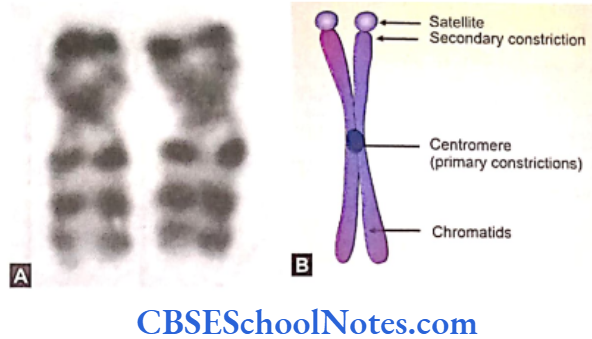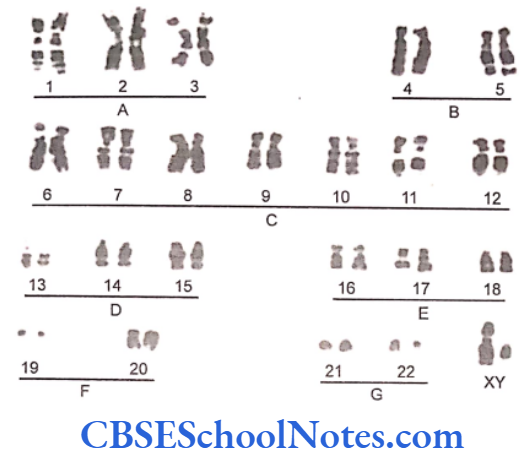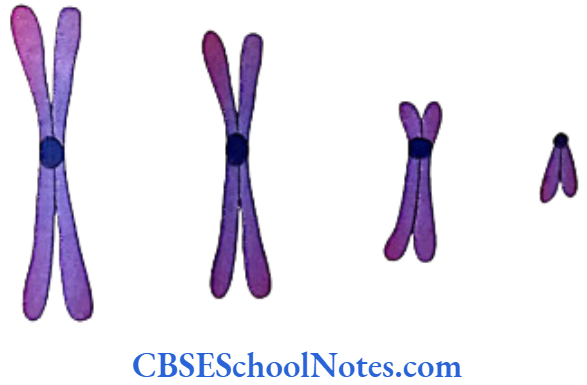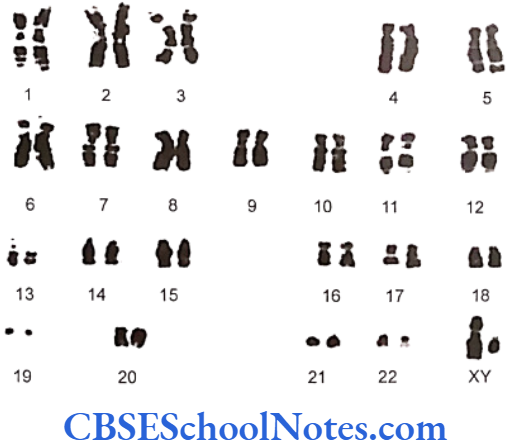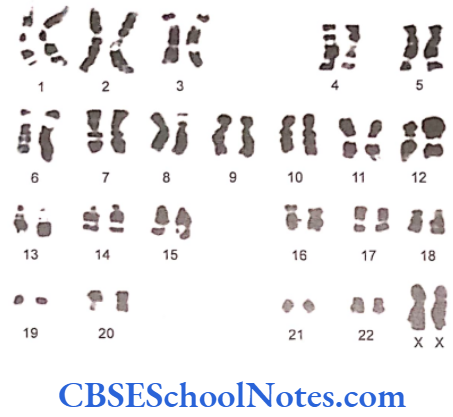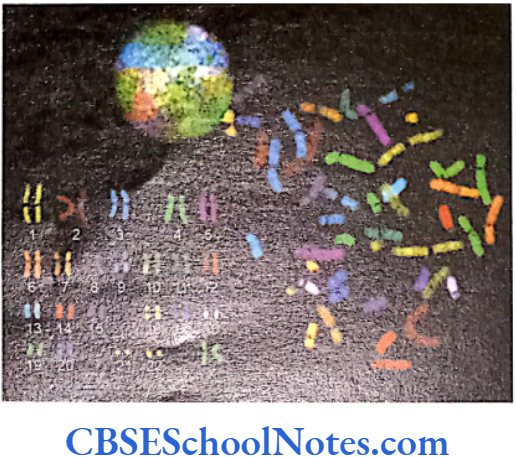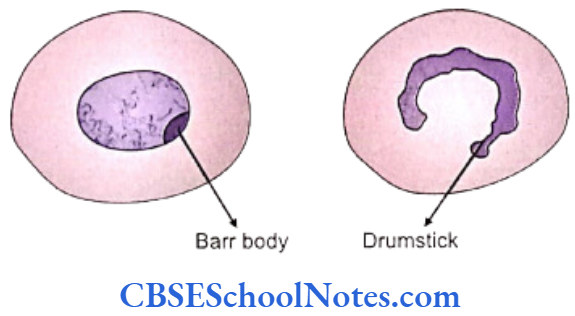Structure of DNA and RNA
The chromosomes are principally constituted of nucleic acids and are structurally supported by protein molecules. However, it is only the nucleic acids that build-up the genes and are linked to the transmission of a trait.
There are two types of nucleic acids.
- Deoxyribonucleic acid (DNA): The bulk of the cellular DNA is found in the nucleus as chromosomes. Circular strands of DNA are also found in the mitochondria. Human genes are made up of only of DNA>
- Ribonucleic acid (RNA): RNA is largely found in the nucleolus within the nucleus. Other locations where RNA is found are the ribosomes and the cytoplasm. RNAs work as functional intermediaries between genes and their final products, the proteins.
Structure And Packaging of DNA
Structure of DNA (Chemical):
Three different types of chemical compounds compose the DNA.
- Sugar molecule – It is called deoxyribose and is a 5 carbon pentose sugar.
- Phosphoric acid.
- Nitrogenous bases.
These are of 4 types:
- Adenine – (A)
- Thymine – (T)
- Cytosine – (C)
- Guanine – (G)
Adenine and Guanine are classified as Purines while Cytosine and Thymine as Pyramidines.
Read and Learn More Genetics in Dentistry Notes



Structure of DNA (Molecular):
- DNA exists in the form of a long polymer which is formed by linkage of a series of nucleotide molecules like in a chain.
- A nucleotide molecule is formed of one molecule of deoxyribose sugar, one molecule of phosphoric acid and one nitrogenous base attached on the sides of the deoxyribose. As there are four varieties of nitrogenous bases, there are four types of nucleotides in the DNA.
- The phosphate molecule in a nucleotide is attached to the fifth carbon atom of the sugar (deoxyribose) and the nitrogenous base to the first carbon atom of the sugar molecule.
- The third carbon atom of the deoxyribose of the next nucletide is attached to the phosphate molecule of a nucleotide. Hence, the sugar and the phosphate molecules are arranged in a linear fashion to form a polynucleotide chain. The nitrogenous base attached to sugar molecule is directed at right angle to the long axis of a single polynucleotide chain.
- All polynucleotide chains have marked ends. It can be noticed that at the upper end of the chain the 5th carbon atom of the sugar molecule of the last nucleotide just terminates in a phosphate. This end is called as 5′ or 5’P terminus.
- The other end of the chain ends in sugar molecule or a nucleotide whose 3rd carbon atom is free and not linked to the phosphate of any nucleotide and bears an OH group (hydroxyl group) instead. This end of polynucleotide chain is called 3′ end or 3′ OH terminus.
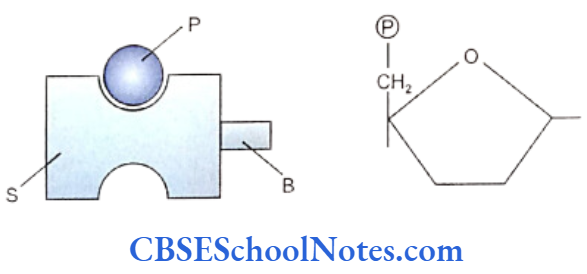
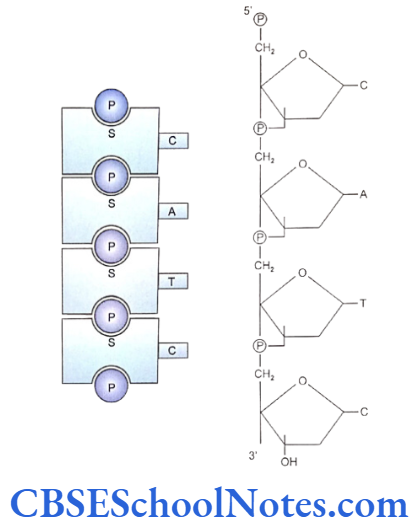
- Waston and Crick in 1953 worked out the DNA helix model as been made up of two such polynucleotide chains which lie side by side but run in opposite directions. One chain runs from its 5′-3′ direction whereas the other in 3′-5′ direction.
The nitrogen bases face towards the inside of the skeleton formed by the two strands of the nucleotide chain.
- The 3′ end of the DNA strand is called the “head” end and the 5′ ends its “tail”.
- The two chains are held together by two types of hydrogen bonds between the nitrogenous bases.
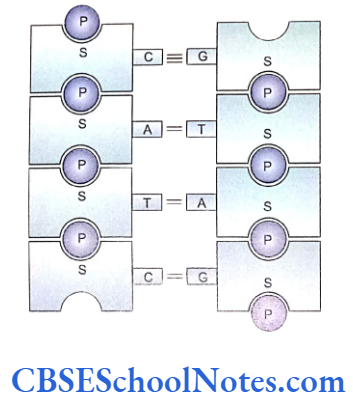
- Pairing between two nitrogenous bases is predetermined and constant, i.e. Adenine(A) always pairs with Thymine (T) and Cytosine(C) with Guanine(G). This specific pairing is due to the fact that these molecules are complementary and the combination of the specific bases facilities stable hydrogen bonds between them. Nucleotides A and T s hare two hydrogen bonds while C and G are joined by three bonds.
- As a consequence of specific base pairing, two strands of DNA are complementary to each other. It means that if the sequence of bases on one chain is A T G C A, then correspondingly, the exactly opposite region on other chain will have the sequence T A C G T that can thus anneal together.
- The double helix of a DNA molecule is formed as the two complementary chains (polynucleotide chains) twist around each other.
A single and complete 360° turn of the helix measures about 3.4 nm along the long axis and contains 10 pairs of nucleotides. The distance between two adjacent nucleotides. The distance between two adjacent nucleotides is 0.34 nm. The diameter of helix is about 3 nm.
One turn of helix measure about 3.4nm and contains 10 pairs of nucleotides.

Packaging of DNA in a Chromosome
A chromosome is composed of a double helix of DNA and histone proteins. The average length of the DNA filament of a single chromosome can extend upto 50 mm but the chromosome is only 5 microns in length when maximally condensed in the metaphase. Thus there is about 10,000 times reduction in length. This is due to the fact that in a metaphase chromosome filament of DNA undergoes several orders of coiling or condensation.
- The primary or first order coiling is due to turning of the DNA double helix on itself.
- These primarily coiled DNA double helix then wind around histone complexes (histone beads). This secondary coiling of DNA filaments around histone beads forms structures called nucleosomes. The DNA filaments wind twice around each histone bead and contain approximately 146 nucleotide pairs. Nucleosomes are attached to one another forming long chains.
- The nucleosomes arrange in a spiral to form a closely stacked thick structure; the chromatin filament.
- Chromatin filament coil again to form chromatin loops.
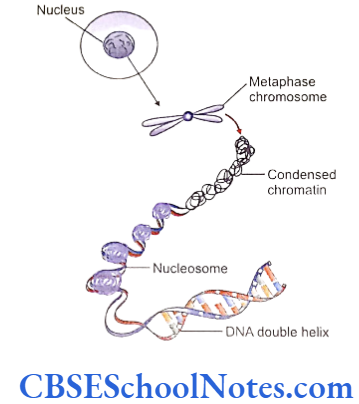
- Additional coiling of the loops on themselves to give the shape of a chromosome as visible during the metaphase of cell division.
These successive degrees of coiling gives rise to the solenoid model of chromosomal structure.
On straightening a strand of DNA taken from a typical human chromosome, it measures about 5 cm in length. It may have about half a billion to 3 billion nucleotides. If we arrange all the molecules of DNA present in the 46 human chromosomes end-to-end, they would measure about 2 meters or 6 ft in length.
Human body consists of approximately 1014 cells and if all the DNA of an individual is joined end-to-end, the total length of DNA would measure approximately 2 x 1014m or 2 x 1011 km. This length would be good enough to go from the earth to the sum and back for about 500 times.
Replication Of DNA
Nondividing cells remain in the interphase stage of the cell cycle. Cell division begins with the doubling or duplication of the DNA content of each chromosome. This event of DNA replication is also called the synthetic phase and results in the formation of two sister chromatids in each chromosome.
DNA replication is followed by the prophase, metaphase, anaphase and telophases of mitosis or meiosis that include distribution of chromosomes and cytoplasm to the daughter cells. The double helix model of Watson and Crick ideally explains the events during replication.

- The tightly coiled DNA filament gets uncoiled during s (synthesis) phase of cell division. The two strands of DNA molecules are separated (denatured) by specific enzymes on breaking the hydrogen bonds between nitrogenous bases. The two separated strands of polynucleotide chains are complementary to each other.
- Origin of replication (ori) are sites along a DNA strand at which replications being. The double stranded DNA gets denatured at these sites and the replication begins on both the strands but in opposite directions. Due to replication, bubble-shaped structures pop up long the chromosome at multiple points simultaneously, called replication bubbles.
- The human genome doubles in approximately 9 hours in a cell with about 100 bubbles being active in each chromosome, each bubble apart by about 40000 nucleotide pairs.
- The region in each bubble at which parental DNA strand is progressively separated with the help of enzymes looks like the alphabet Y. The stem of the Y is formed by the double stranded DNA whereas the two arms of the Y are made-up of the dentured single strands. This region of on the chromosome is called the replication fork. The total replication time is reduced as each chromosome replicates by many thousands origin sites.
At each replication fork about 10 to 100 nucleotide pairs are added per second. A chromosome usually takes 15 to 30 minutes to replicate. Because all the chromosomes of a cell do not replicated simultaneously, complete replication of all chromosomes of a cell takes 8 to 10 hours.
- As specified by the rules of base pairing, each nucleotide of an old chain attracts is complementary nucleotide that attach through hydrogen bonds with their complementary nucleotides on the old chain.
The growing end of a replicating new DNA strand elongate with the addition of one nucleotide at a time
- The phosphate components link the sugar radicals of neighboring nucleotides to each other. Thus a new chain is formed opposite to the old polynucleotide chain. The new chain grows only at its 3′ end.
- the genetic information is conserved and transmitted unchanged to each daughter cell as the new strand is identical to the old template strand.
- As the newly synthesized DNA double helix contains an original or old strand (that is said to be conserved as it comes from the parent) and a newly constituted complementary strand, this method of DNA replication is described as semiconservative.
Mitochondrial DNA
In addition to the nucleus, the mitochondria also contain DNA. Mithochondrial DNA, similar to the nuclear DNA, is double-stranded but arranged as circular structures. It consists of about 16.6 kb nucleotide base pairs and codes for 37 genes with 22 genes for tRNAs, 2 for rRNA and 13 genes for enzymes responsible for oxidative phosphorylation.
Oxidative phosphorylation enzymes are involved in energy production. Therefore mitochondrial abnormalities are associated with the loss of coupling between oxidation and phosphorylation. Presentations of mitochondrial disorders are variable because of the phenomenon of heteroplasmy. The characteristics and examples of mitochondrial disorders.
Mithochondrial of sperm are not transmitted into the oocyte during fertilization and the entire mitochondrial complement in the zygote is derived exclusively from the mother. Thus mitochondrial DNA abnormalities are transmitted only through females and follow maternal pattern of inheritance. Both sexes are equally affected.
mtDNA acts as excellent genetic markers for tracing human ancestry as they do not undergo genetic recombinations during gametogenesis, similar to what happens with the Y-chromosomes. It is established that about 1 change per mitochondria lineage occurs in every 3800 years at a constant rate. This fact helps us to estimate that modern human population originated somewhere in the Sub-Saharan Africa approximately 130,000 years ago and migrated to various parts of the world.
They first moved out of Africa tot he Middle-East about 100,000 years age and from there to the east and south Asia (67,000 years age). The journey continued to Australia and to Europe anout 40,000 years ago. From East Asia migration went on further to North America (about 20,000 years back) and from there to South America about 13,000 years ago.
Structure Of Ribonucleic Acid (RNA)
Both the nucleolus and cytoplasm contain RNA molecules. RNAs work as functional intermediaries between genes and their final products, the proteins. RNA is not concerned with inheritance in human beings. It is synthesized by reading DNA template molecules with the help of ribosomes.
There are three types of RNAs.
- Messenger RNA (mRNA)
- Ribosomal RNA (rRNA)
- Transfer RNA (tRNA).
Messenger RNA (mRNA)
The nucleus is the site for messenger RNA (mRNA) synthesis. It is single stranded product of transcription. mRNA is formed at transcription bubbles with arrangement of nucleotides on the template strand that is read from its 3′ to 5′ end. mRNA itself, thought, is synthesized from its 5′ to the 3′ end. It thus carries all the genetic information present on a particular segment of the DNA strand in the form of sequence of base arrangements.
However, there is no thymine in mRNA and has a uracil molecule instead. Several hundred to several thousand nucleotides arranged in a single strand compose a messenger RNA molecule. mRNA comes out through nuclear pores into the cytoplasm after its formation in the nucleus. Soon it gets attached to ribosomes outside the nuclear envelope.
The protein synthesizing apparatus of the cell utilizes the genetic information on the mRNA for translation of proteins. mRNA population constitutes about 10% of the total RNA present in a cell. The life span of mRNA varies from few hours to few days.
Ribosomal RNA (rRNA)
About 80% of the total RNA present in the cell is contributed by rRNA. As implied, rRNA occur in ribosomes. The part of the DNA which codes for rRNA is associated with formation of the nucleolus and is called the nucleolar organizer. DNA loops of chromosomes 13, 14, 15, 21 and 22 contain genes for ribosomal RNA and constitute the nucleolus. rRNA is produced inside the nucleus.
Two subunits, a large and a small, make-up the ribosome. The rRNA molecule occurs as three different dimensions; the 28s, 18s and 5s units. The large ribosome subunit contains the 28s and 5s molecules. The 18s molecules are present in small ribosomal subunits.
Ribosomal RNAs in the ribosome initiate as well as maintain the process of protein formation (translation) by interaction with the mRNA strands as they pass through the ribosomes.
Transfer RNA (tRNA)
Consisting of about 75 to 80 nucleotides, a tRNA molecule is single stranded and is synthesized at particular regions of the genome. The tRNA molecule isbent in the middle of the polynucleotide chain and forms two arms on its sides named clover leaf model for obvious similarly with the structure.
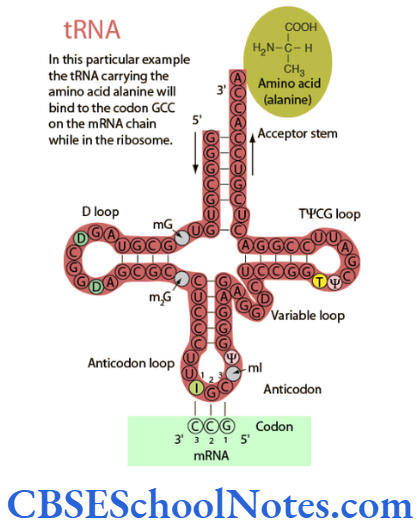
A specific amino acid is designated to each tRNA molecule and hence 20 types of tRNA exist in the cytoplasm. A tRNA with its amino acid (amino-acyl tRNA) is transported to the ribosome where it docks and pairs on the mRNA molecule after being correctly recognized for such a base pairing. Protein synthesis and chain elongation occur with the sequential assembly of the amino acids by the tRNA on the mRNA molecule. Four different special sites are present in the tRNA molecule.
- Recognition site – Recognizes the appropriate amino acids to be attached with the help of specific amino-acid sequences.
- Codon recognition site – A 3 base sequence site that is complementary to a sequence of three bases (codon) on the mRNA molecule. Base pairing between tRNA and mRNA happens at these sites after tRNA molecule lands on the mRNA.
- Amino acid attachment side – This sites attach specific amino acids after their correct identification.
- Ribosomal recognition site – This site facilities tRNA to recognize their specific positions inside the ribosome.
Following are the difference between DNA and RNA molecules.
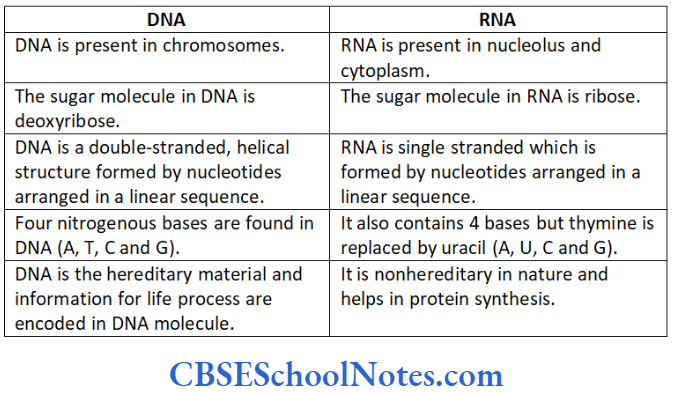
Structure Of DNA And RNA Summary
- DNA
- Eukaryotic genes are composed of DNA molecules and are responsible for inheritance of characters. DNA is present in nucleus (chromosomes) and mitochondria.
- DNA is in the form of a long sequence that is formed by adding up of nucleotide molecules as in a chain. (A nucleotide molecule itself is formed of a single molecule of deoxyribose sugar, a single molecule of phosphate and single nitrogenous base).
- The DNA molecule is made up of two hightly coiled and condensed polynucleotide chains (double helix) which lie side by side but runs in opposite directions (antiparallel).
- There is strict and definite pattern of pairing between the bases of the two parallel running DNA strands.
- During cell division chromosomes (and the DNA) duplicate themselves by the process of replication.
- The process of replication generates a new strand of DNA (semiconservative) against each old and complementary template strand.
- RNA
- RNA does not constitute eukaryotic genes and therefore is not a heriditary material.
- RNA is abundant in the nucleolus as well as in the cytoplasm.
- The sugar molecule in RNA is ribose and nitrogenous bases are A, G, C and U.
- There are three different types of RNAs (mRNA, rRNA and tRNA) which play an important role in synthesis of proteins.


